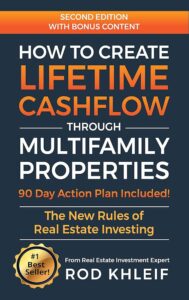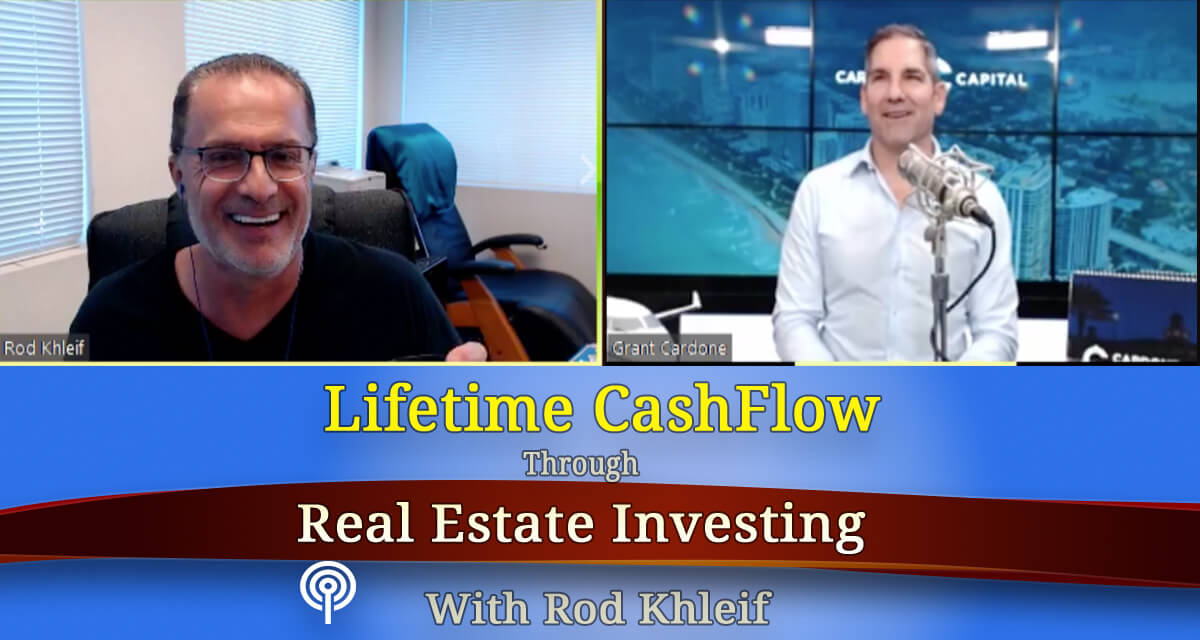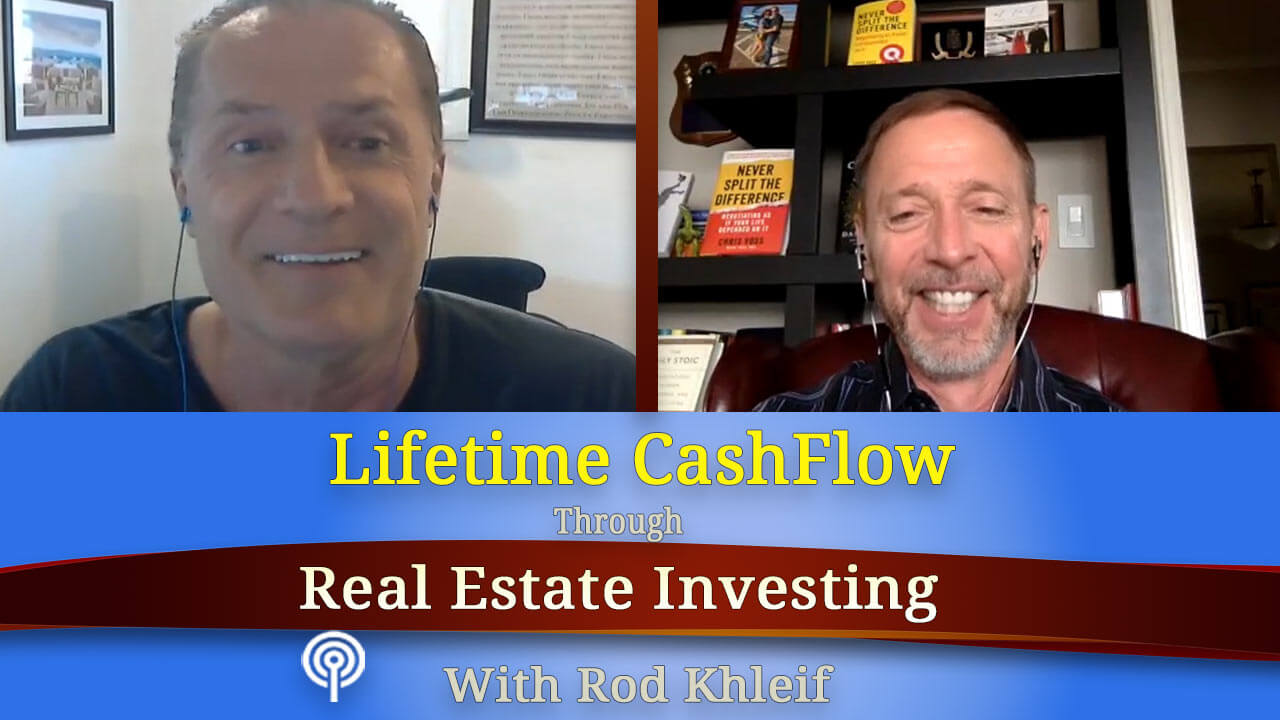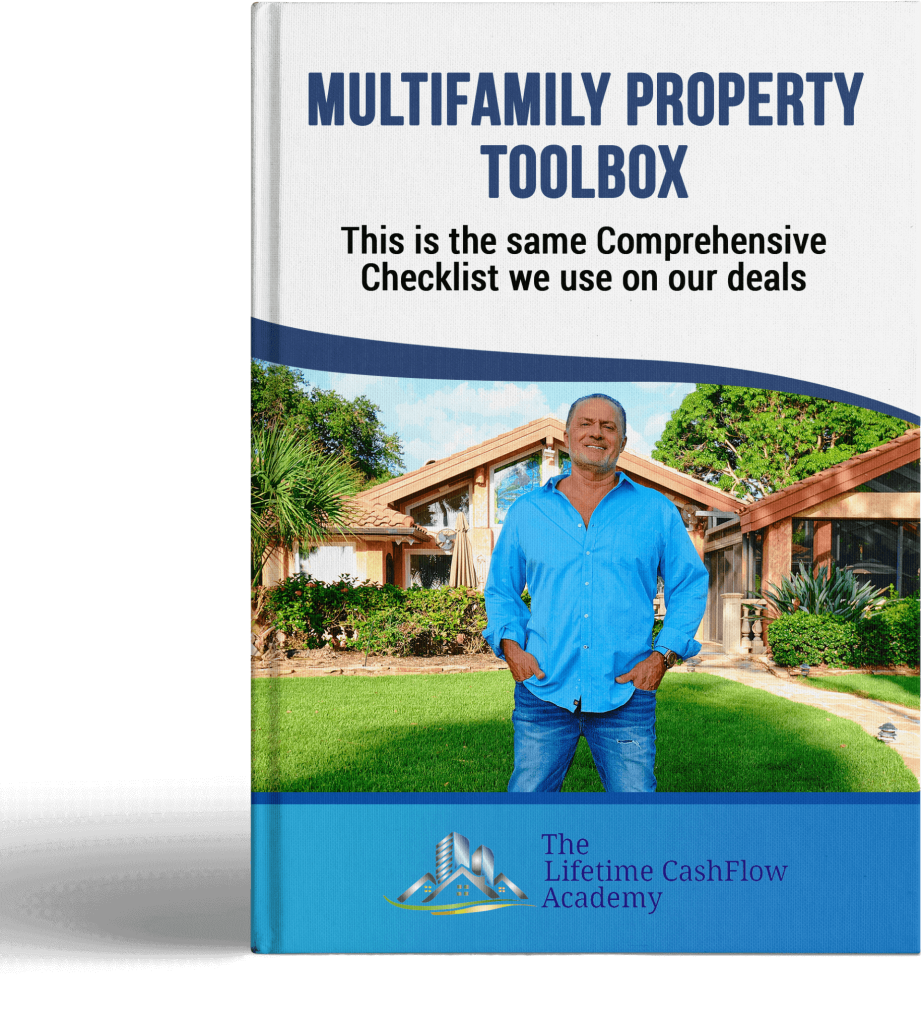Ep #306 – Neal Bawa – From Tech Exit to $150M Portfolio
Here is some of what you will learn:
Market Selection
What to look for in population growth
Importance of using city.data.com
What to look for in income growth
What criteria to use when selecting a neighborhood
Why you buy for ‘bad times’ and not for ‘good times’
Discover the five steps to property optimization
To learn more about our guests click here
Join us at a Multifamily Bootcamp, visit: MultifamilyBootcamp.com
Full Transcript Below:
Neil Bawa – Optimizing Multifamily Profits (Ep306)
Intro: Hi! I’m Rod Khleif. Each and every week I record an interview with a thought leader that I know you’re gonna get a ton of value from. Now here on YouTube are the video versions of my podcast, Lifetime Cash Flow through Real Estate Investing. Now to make sure you get the latest information please subscribe and hit the notification bell. Let’s get started.
Rod: Welcome to another edition of “How to Build Lifetime Cash Flow through Real Estate Investing”. I’m Rod Khleif and I’m absolutely thrilled you’re here. And you are really gonna enjoy the guest that we have on the show today. His name’s Neil Bawa and maybe you’ve already heard him on one of the other podcasts cuz he gets around a lot but Neil’s invested in over 1,500 units or beds because he’s also in student housing. He’s an educator. He raises a significant amount of equity every year. He’s a self-proclaimed tech geek and just a really brilliant guy. So we’re really blessed to have you today Neil. Welcome to the show my friend!
Neil: Thanks so much Rod. I’m delighted to be here. I’ve been trying to get on your show for a while thanks for having me
Rod: All you had to do was ask my friend. I you know it’s funny I was telling you before we started recording that you know so many of people have said have told me you got to get Neil on the show you got to get Neil on the show and I don’t remember who they were now but but I’ve heard your name come up so many times. It’s kind of a no-brainer. So I’m really glad you’re here and we’re gonna drill down on some topics today that we don’t normally kind of broach but before we do you know give my listeners just a little bit of a background on who you are and where you came from if you would
Neil: Sure Rod. I am NOT real estate royalty and I haven’t done a hundred loans or flipped a thousand homes. I am a technologist and I’ve had a full and complete tech career and a successful tech exit. And I actually used the money that I’ve made from that technology exit and I invested it in two single-family I bought ten homes in California, the name bought ten triplexes in Chicago and and I realized and you talk about this a lot is that stuff is non scalable right. I realize it wouldn’t scale and couldn’t get enough loans and was going crazy managing and so I started to invest in passive syndication so people like you and when I started doing that, I realized oh this is substantially better, this scales a lot better and the quality of management is a lot better, and so I started getting curious about him this is back when I’m still in my tech company, you know I’m managing 400 employees and I’m just getting curious about what is the syndication stuff and I’m learning more and more about it and eventually I said, I’m learning so much good stuff that if I don’t teach this to somebody, I’m going to forget it. So I opened my own meetup group and I started teaching this stuff and people really liked it because they knew that I was a technology so I had nothing to sell, I had no active projects or anything like that. I was just there every month saying this is all the cool stuff I’m learning from all these podcasts and this other stuff and here’s how I’m implementing it in my small portfolio of thirty five minutes. And people really loved it they kind of lapped it up and then I started using virtual assistants. One, two, five, six, virtual assistants and I started telling people how to hire and manage and structure virtual assistants for for growing income levels and so people liked it. So eventually when I sold my company in 2013 then slowly I transitioned full time into multifamily, became a syndicator, started off with the you know three investors in my first project and now I have about 300 investors. So the portfolio’s grown to 150 million and we are now growing it aggressively
Rod: Look at you, beautiful, beautiful, and you know what’s beautiful about it is that it came about as a result of you adding value to other people you know and it’s just funny how the universe works and the same thing has happened in my life you know with this podcast and now my coaching business and all that is you know those that have the most value reap the most rewards and I think that just doesn’t matter what industry business interest you have you know that mindset is really the mindset to have I love it. Well you know before we started recording I asked you what some topics would be that you enjoy talking about. So you know I believe in playing to people’s strengths and you brought up a couple. So let’s get into those let’s drill down immediately so we can add as much value today as we can. And so I know that you enjoy speaking about markets selection, city selection, even drilled down to the to the actual neighborhood selection. So let’s get into that right out of the gate if you don’t mind
Neil: Absolutely. So I call these real focuses when I’m you know teaching my meetups and I’m gonna give you a list of real focuses and then I’m going to give you a button bunch of ranges right cuz you’ve heard all of these real focuses before but you what you haven’t heard is the ranges. I’m a data scientist so I’ve done what is known as back testing. So you basically say is this the right range and then you go test it on a hundred cities then you say he’s at the right range and then you go test that on 100 cities. So these are back tested over thousands of experiments that I’ve done over the last five years. So my first real focus what I’m investing in a city is population growth okay. And I warned roughly and I use it a site called city-data.com to look at this and we also use Google for population and what I want to see is that since 2000, has this city gone up at least 20 percent in population? I want there to be a 20 percent increase in population in the city. Now if the cities as large as Los Angeles I cut that to 10 percent. So New York, Los Angeles, Chicago, 10%, big cities don’t grow as much but 20 percent. Good examples of cities that are like that Phoenix, Orlando, Las Vegas, Columbus, Ohio, that’s actually one of the only Midwest or Rust Belt cities that that matches that scenario. And then you have a bunch of cities that would match that scenario they’re not bad cities to invest in but in general I’m trying to invest in the best cities right. Number one is population growth and you’re looking for 20% since 2000. My number two real focus is that I want the income levels in those cities in the same time frame and you can get that at City-data.com for any city just type in the name of the city
Rod: Another one is bestplaces.net even census.gov will give you that information as well. So if you’re taking notes write those two down as well please continue.
Neil: So I go there I look at the amount of income growth that I’ve seen and I want a 30% growth in income since the year 2000
Rod: Wow
Neil: Twenty percent population, thirty percent income growth. What that really implies is that that city is keeping up with inflation because if a city doesn’t keep up with inflation, in the long run you end up with high levels of delinquency in Class C properties very much
Rod: Make sense you came up with this by evaluating all these different cities just to come up with these key metrics that you like to target love it
Neil: Absolutely I’ve done I’ve done over 200 cities that match these numbers the new metric leads from the first two and three so what was the first one twenty percent the third second one was 30 percent guess what the third one is, it’s 40 percent. I want to see 40 percent increase in the median house or condo value. So when you see a population growth that tends to lead income growth because employers are fighting for employees and that tends to lead to house growths 20 percent growth in population will lead to 30 percent growth in income which leads to 40 percent growth in household value. All since the year 2000. That’s my three real focuses and you’ll find a whole bunch of cities in the US that qualify or just qualify for example Columbus, Ohio one of my favorite examples, almost exactly qualifies for all three metrics, almost exact all three numbers almost exactly. My fourth number, my fourth real focus is crime. So on any city data page you’ll see a crime table. Go to the bottom of the crime table the blue row, and on the left side you’ll see a number that is the old number I think it’s from 15 16 years ago and on the right side you’ll see the number for last year. You want the number for last year for any city in the US to be under 500. The crime number for any city should be under 500 and one other thing, you want the number on the left to be higher than the number on the right. What that means is crime was very high back then and has come down. So an example so you know you’ll find that cities like Boise, Idaho are at 300 very very low crime cities in the US, Eugene, Oregon very low crime and then you’ve got very high crime cities what is the highest crime city in the US? Its not Detroit, its St. Louis, New Orleans very close right. So St. Louis, New Orleans, Detroit, very very high crime. Memphis is really up there 850 or 900 but what I’m looking for is the pattern. I like to invest in Orlando and my you know people that listen to my podcast have said but Orlando’s at 550 and I say yes but look at where it was 15 years ago it was at 900 something is happening in this city where crime is reducing at a very accelerated rate. Usually it’s education right? Most of the time if education levels on the same citydata page are going upwards you’ll see a reduction in crime at the same time. So those are my four real focuses. If you apply these for real focuses that 20, 30, 40, 500, you’re gonna basically stay away from cities that are not going to appreciate well in bad times. Please note that in good times every city appreciates. I keep hearing about Detroit doing well. Yeah of course it’s doing well, every city in the US is doing well and so Detroit’s doing well as well but have you seen the population loss? It went from 1.7 million to 600,000 people and at no point over the last 58 years has it stopped declining in population?
Rod: That’s a clue. Guys that’s what we call a clue okay
Neil: Right and people are still looking to invest there they don’t realize that the cap rates that started off in 1959 at five cap are now up to 12 and going and rising and rising right, so you may make money today in cash flow but you still have to sell this property five or ten years from now at a higher cap rate
Rod: Yeah there’s no exit strategy guys and sure you can buy D-class assets as well as well in other markets but your only exit strategies cash flow this you know if you’re buying bottom-of-the-barrel properties in in in declining areas there’s no exits. All right that’s very insightful. Love that framework and those metrics that gives clarity – you know – a lot of people as to what to look for when they’re doing that initial analysis – to determine what markets to invest in. Love it
Neil: Okay the key is the neighborhoods because Rod you know this and I know the really strong cities today cities like Phoenix are still gonna have really awful areas right. They have D areas too and so you’ve got to look at the neighborhood real focuses and the first neighborhood real focus is again income and how do you find the income for a neighborhood? same page city data scroll to the map and go, so let’s say you’re looking in Phoenix you’re gonna see the Phoenix map and you’re gonna notice that it’s broken up into tiny little blue pieces. Well click on whatever piece if you, if you’re looking in Scottsdale, well go click on the Scottsdale piece and you’ll you’ll see neighborhoods in Scottsdale, click on them and a box will open up. Inside that box the first thing I want you to look at is the income level for that neighborhood. It has to be between forty and seventy thousand. Forty thousand lower, 70 thousand upper bound. Why an upper bound? because it’s not gonna cashflow beyond 70 thousand you’re gonna have trouble basically buying it and getting cash flow for your investors. If you’re an appreciation guy, go above seventy, go to ninety but if you’re actually looking to syndicate or you’re looking to buy a property where you want eight, nine percent cash then your forty to seventy sweet spot is perfect you can go a little bit lower than forty in the Midwest maybe 36-37 but don’t go below that because
Rod: Tell me why tell me why
Neil: I have found at the moment you drop below forty thousand dollar household income that number is very strongly tied to increase in delinquency. By the time you get to cities there are at thirty two thousand your delinquency levels are three times higher but what I found is between forty and fifty thousand, there’s only a slight decrease in delinquency. So obviously as ten people get richer your delinquency levels decrease but forty seems to be that magic number right now in the US where you get reasonable delinquency and reasonable cap rates
Rod: And then on the upper level what happens if you go above the seventy thousand? please clarify
Neil: I find that the numbers don’t pencil out. So basically there are great properties there are great properties in great areas but I’m struggling to meet cash flow requirements though they might do really well over five years. So if I was running a REIT, I’d go over seventy because my when I’m running a REIT I make all the decisions, my investors don’t make any decisions, and I think those are great properties that I’m buying. But what I’m finding is that I’m when I’m when I’m significantly pushing over 70 I find it very difficult to get to average you know seven or eight cash and so given that I’m a syndicator, that kind of knocks those properties out for me. They shouldn’t knock it out for you if you’re making all the decision and you’re putting in all of your money
Rod: Right right right right right sure sure and you and/or if you’ve got no cost of funds like a REIT really and effectively you know some of these you know insurance companies things of that nature
Neil: So that’s the first one
Rod: So that’s the first one all right keep going
Neil: The second one is in the on the same box right below where the income is, you’re gonna see poverty level. Never ever invest in a neighborhood where poverty level is over 20%. That is the the most important metric that I’m going to give. Yo go over 20%, your churn levels your constant churn where people are coming and leaving or you’re forcing them out because they’re being evicted right your churn level will kill every single dollar of your profit 20 is dangerous
Rod: Ask me how I know. No no no I just I’m becoming a little notorious for that statement because I’ve made every mistake that can be made and what you just described was you know my typical portfolio that I had in Denver and I had then and I was in Memphis very ingrained in Memphis what I call that a seminar as well but it but the thing that kills you the most in this business is the churn, the turnover because that’s the most expensive. You’ve got vacancy you’ve got make ready costs and that’s what killed me here in 2008 when I lost 50 million dollars was that churn. And so so really really grateful to hear that from someone else and acknowledge you know that that dynamic and to alert you guys to beware of that. So poverty level definitely impacts that no question. You buy in tough areas, you’re gonna have that turnover, you’re gonna have that delinquency. So please continue
Neil: So I tend, for my properties I tend to be below 15%. So I’m a little more conservative, I tend to be. So if your conservative stay below 15%
Rod: okay
Neil: Next metric which is right next to the poverty metric is the unemployment rate for that neighborhood okay not for the city. This one’s a slightly more complicated. So it’s two step. So you open a new tab in your browser and you google the unemployment rate for your city. So let’s say you’re looking at Phoenix to Google unemployment rate Phoenix and Google will give you a beautiful chart right now I think Phoenix is around three and a half percent right. So write that down now go back to that neighborhood that you clicked on and make sure it’s unemployment rate is not more than two percent higher than the city’s. So if the cities are 3.5 you can be at 5.5. If the city’s at 6, you can be at 8 but if the city is at 5 and this is at 12, the moment a recession hits, this area’s unemployment rate is going to skyrocket and go above 20. And now you end up with massive poverty problems and delinquency problems and nobody paying rent. So it is okay because it’s you’re typically buying in cash flow classy areas to be a little bit above the city’s level because obviously classy areas in the city might be at one percent unemployment right we’re not comparing with those. So be two percent above at the most be three some people some some metros like Memphis or St. Louis you can be three percent above but more than that what you’re saying is, I know I’m buying in the area that has unemployment trouble and for the moment because the economy is good this is great but you know that you don’t buy for good times, you buy for bad times
Rod: Let me let me stop you there. Guys guys I just want to hammer that one home okay because I you know Robert and I were just talking about this the other day. We watch other people’s offering memorandum presentations on syndications that they’re doing and we’re just watching one the other day and Robert asked you know how’d you stress test this deal. And they said we didn’t. So it’s gonna be perfect forever. There’s not going to be any speed bumps in the road I just you know what stress testing means is is you look at what happens what ifs you do what ifs, what happens if the vacancy drops fifteen percent? what happens if your rents pull back? you know you’re realistic about a deal and so I just want to hammer that point home. Thank you so please continue
Neil: So those three are kind of my real focuses for neighborhoods. I have a fourth one which is subjective. Everything I gave you so far is a number right. The fourth one is this and please understand that it’s not a racial comment it’s a demographic comment, I’m a demographer okay. When in the same box, you’re gonna see a pie graph and that pie graph is going to show you the ethnic or racial mix of the people living there. For best properties make sure that there are two slices or more. You never want to go into an area where basically all of your tenants are going to be let’s say white or Chinese or Mexican or African American because now what you’re doing is you’re reducing your marketing efficiency tremendously because you can only target one audience. So when you see that pie graph, I want to see a pizza slice that’s about 25 percent right and obviously there’s gonna be one big pizza slice. So it could be you know whites or 70% and an african-american Americans are 25% that’s a great market to go in. What you don’t want to go into a market if for example where one pizza slice is 95% you will have huge amounts of trouble marketing your property especially in bad times
Rod: Well I tightened up when you started that conversation but I felt better. I felt better after you said it and that’s very astute and very accurate you know and it doesn’t matter what demographic you’re talking about you’re gonna have that issue if it’s the the you know the the entire pie so well well said. So now let’s talk let’s shift gears cuz that was that’s neat that’s the neighborhood correct that’s the neighborhood
Neal: For statistics for neighborhoods yeah love it love it incredible value you added Neal, incredible. You’re living up to what people have told me about you. So the next thing I want to chat about which we chatted about this briefly is when you buy an asset you buy a property and it’s not it’s chugging along you’re having some challenges with it. I know that you’ve got a kind cool framework with its own acronym as to how you go about identifying where the issue is andI’d love for you to dig in on that so please take it away
Neal: Absolutely firstly note that this is not something that we do for every one of our properties. If it’s doing really well leave your property manager alone, do your weekly meetings pat him on the back. But very often you’ll have properties that are not doing well you’re targeting ninety five percent occupancy, you’re at ninety or you are at ninety five percent occupancy but your economic vacancy is very high basically there are a lot of these people are not paying so you know you have to kick them out and get new guys in. Well so now you need to figure out you need to understand your property and you need to understand your tenant base and your marketing base. I do this through a five-step process and I call it LASAL. Now the first L stands for leads the people that are interested in your property. The second one stands for Appointments the people that set appointments to come to your property. The third one are called Shows, people that actually show up after setting an appointment. The fourth one are the people that are signing Applications that’s A. And the last L is people that sign Leases. L, leads, appointments, shows, applications, and leases.
Rod: And guys guys you should write this one this stuff down because that what he’s gonna explain here is so obvious, we had someone else to a presentation of my multifamily boardroom that spoke about something similar this is, so common sensical but so many operators lose sight of this. So pay attention very closely here keep going my friend
Neal: Sounds good so now I always start with the leads. First I want to see what the number of leads is for my property right and there’s rules of thumbs basically here’s a rule of thumb and obviously depending on the property it’ll vary. If you’ve got a property that’s very tough to lease, then you need a lease every month oh you need one lead per unit per month. So if you’ve got 244 units you want 244 leads every month. That’s a rule of thumb you might need less you might need more but that is a good rule of thumb to start you want to split
Rod: Just to know I’ve heard you correctly depending on the size of your property, you’re saying if it’s a challenge to lease that property you should have the same number of leads as the number of doors that you have
Neal: Exactly. So now you’ve got this 216 unit property do you have 216 leads? And if you don’t have 216 leads then focus on that. What is your property manager doing? What are the some of the things that you could do? There are so many things that you could do on your own. A property manager is simply going to say I use appFolio and I put these properties in appFolio and when I put them in appfolio I get leads and that’s my system. There are dozens of tenant marketing sites out there that are not reached by AppFolio. There are so many strategies that you can implement. I have full-time people employees that I pay full time that just click on ads. They do nothing except click on ads why because every time you click on an ad that’s your own you refresh it, it goes to the top of the stack Wow right full time employees I kid you not. That’s how powerful this is. So you as a syndicator need to look at the leads and try to get them as close to that benchmark that I gave you as possible.
Rod: So let me ask you this where are they clicking on ads? Obviously you’re not paying for those ads because you’d be paying for those clicks. So give me an example of where they might be clicking on an ad to refresh it?
Neal: So rent links for example is one of the the big ones where we click on ads. Zillow rental manager. Let’s go for zumper Pro some of these are paid but compared to the marketing budget of your property, what you’re paying is is nothing just really nothing it’s not gonna move the needle okay it’s gonna move the needle on those leads. Now here’s what happens very often you’ve got now 216 leads coming in you did your magic you work very hard and now when you’re looking at the number of actual appointments, you’re not seeing many appointments well you’re the reason for that is your internet your manager your property manager thing that internet leads our pardon my friends, shit leads they call them shit leads right. And so here’s the truth. This is what it is an internet lead is gold in the first five minutes, silver for the next two hours, and then shit after that
Rod: Interesting interesting how do you maximize that timeliness?
Neal: Simply simply by doing this, every property that we have Rod, we ask for the login for the phone logs you know, they’ve got an electronic phone system right that has a log somewhere AT&T Comcast whoever’s there there’s a log, we get our virtual assistants to pull that log and we force push, hard, nudge, whatever we have to do to get the property manager to understand this an internet lead is no different from somebody walking into your leasing office. When someone walks into the leasing office and you’re doing some paperwork, guess what you do you put the pen down and you walk over and you greet them. Why would you treat an Internet and he different? He just walked in through your virtual door
Rod: Love it
Neal: Therefore when that lead comes in, it is your job to call them back.So we do two things, we do a report that shows what percentage of incoming leads that come in during that eight to five time frame were addressed immediately, immediately being five minutes and then we incentivize our property managers to increase that percentage. And we incentivize the leasing agent so we say you know for above 30%, every single lead that you call within the first five minutes is a dollar
Rod: Wow
Neal: Right now in a year I might give away two thousand dollars but I’ve now turned a lot of shit leads into a lot of gold leads why? Two reasons Rod. Number one guess what happens when someone’s on apartment.com? he’s searching and he sees your property, he clicks this button and he says okay I want an appointment and then top types, yeah he’s that information now stays in the box so for the next one he just has to click one button he doesn’t even have to type it in and then he’s just going click click click click click. . . and before you know it he’s signed up to 16 of these properties and he really doesn’t have a desire to take 16 phone calls. So get guess what happens the first two guys that set an appointment are it and everybody else he just never returns their calls. That’s the difference between gold and shit leads right. So now you’re pushing people to do that guess what will happen? You bumped up your leads, your appointments have gone up. Now your shows, your shows only go up if you text message people the day before and the day of the appointment. That is the only goal there. We push our properties to text message please don’t bother emailing them it is a total waste of your time, text message them the day before, text message them their day off and in both of those text message include the actual address of the property so they can cap and use Google to get there and not waste your time calling the leasing often and saying where the heck are you?
Rod: Love it love it that’s so it’s so simple and so freakin obvious love it
Neal: The key is to have systems to audit your property manager on all of these right. So that is gonna get you shows
Rod: How would you do that here I mean how would you audit them
Neal: So we we gave them a texting software and they have to text using that software. In our case we use Ringcentral and textedly so it’s like when you’re texting people, don’t use your smartphone use this software and now with with appFolio you can actually text from appfolio and when you text from a folio it’s the it’s stored in there right. So lucky if they’re using that folio it’s easy for us if they’re using , then it’s harder then we give them something. So now we’ve got LA and S taken care of now we’ve got now we’re getting to our actual apps. So you got 20 shows and you’ve only got three or four apps well dig in. What’s causing the problems? Number one it could be that your property manager is always gonna say, oh these were non qualified people right but you want to dig into that. You want to see if he’s telling you the truth or not. If he’s telling you the truth well you know you didn’t go do a good job of buying the property in the right place so you call you can do is go back and increase your lead flow, work harder on the lead flow. But most of the time what is happening is that they’re not selling the property the leasing agent doesn’t think that he’s a leasing agent he thinks he’s a showing agent. They don’t actually sell the property so you’ve got you got 20 people because Neil did a great job getting all these leases in and now he’s got 20 people in front of him and he only signs 2 AP’s that’s because he’s not showing the property. There are courses there are marketing courses available apartment marketing courses you need to get those people through sales courses these people through the sales courses and then track them again after the sales course you’ll notice a huge increase right after the sales course but it’s gonna die down if you don’t keep mentioning it to them that they have to keep going back. What I like to do is do the sales course twice. Do it and then do a repetition three months later and that kind of sets it in their mind that this is the only way to do this and then the last pieces, ordered their phone logs to make sure that they’re following up with those 18 people that didn’t sign apps. You had 20 shows, two of them signed apps, what about the remaining 18? They didn’t say I hate your place, they said I’m not ready. Well is there a process to call them back when they’re ready? is there a process to capture when they’re ready? because a lot of them say oh you know I’m just looking I still have three months left on my lease great. Do you have a process of immediately adding a follow-up call back in appFolio to call them a month from now. If you don’t, you’re just simply saying I’m gonna throw this lead away. That’s what you believe
Rod: You spend money to get, you spend energy into you know so do you ever so your framework is a call back solution? is that is that
Neal: It’s a call back so that basically you have to you have to have a call back and you can also have a text back we haven’t implemented text back yet but we’re moving in the direction of having text back saying hey you came in for a showing, we are a wonderful showing, now that you’re getting close to the end of the lease let’s have you back we’ve got better units nicer units we’ve changed this we’ve improved that, now you’re bringing them back in right. The last piece of the process is to get from the applications to the meetings. You want and every every area is different obviously you’re looking at the demographics if it’s an area that is really poor demographics, you want to be careful that that ratio is not too high. If you have ten applications if you have eight leases you can end up with a lot of bad tenants especially in an area that’s low-income. So you want the property manager to do his job and call a bunch of those people get rid of those your screen and do the proper screening not just that any person that darkens your doorstep okay and then on the other side you’ve got property managers who’ll take ten apps and only approve two or three because they’re elitists. They want to make this a heaven. This is in heaven this is a Class C property right and not only is that property manager doing bad by you, he’s actually also not obeying fair housing laws. So he’s gonna you know in lots of different ways so you want to have this this narrow band of approval levels that are between 35 and 60 percent depending upon your prop
Rod: So you like that ratio that’s very interesting. And guys this process has some real subjectivity to it although with Fair Housing it shouldn’t but it does and I love the fact you’ve drawn attention to this because you’re absolutely right. It can very often be one extreme or the other and neither are good, in fact the first example is even worse than the second if you bring a bunch of people in and you’ve got that churn in that turnover then it becomes very expensive. I’d rather have a place that empty then then get the wrong person in it but you can add the other example as well where they’re just not letting anyone in because they’re an elitist okay fascinating
Neal: By the way if you hire a class A manager for a Class C property you almost always end up with that elitist problem. They just hate all of the people that they’re looking at right that’s what they’re used to they used to much better tenants. So never make that mistake you know because they may be the most awesome property manager in the world but they are gonna do a horrible job for your property
Rod: Right and we’re talking about the actual company as well. If you’re you know when you’re interviewing third party property managers, if their portfolios primarily A properties they’re gonna excuse the expression suck with your see property and vice versa. If they’re you know if they specialize in C and D properties, A’s are a completely different animal. They can’t handle it so be very very cognizant of the class of properties your third-party managers are managing
Neal: So we started with five numbers right LASAL, and those all of them will have numbers your job is to figure out the right numbers that you want to push your property to words. These are goals that you’re setting for your property manager but you know what’s really important is the numbers in between. We call them ratios so you look at my hand and you’ll see that there are four gaps between the five numbers. These are called ratios the first one is an L-to-A ratio right lead to appointment. So if you have a hundred leads and you think that based on the quality attendance and you’ve done your studies that you should get 40 percent of those people in for an appointment then your L-to-A ratio is 40 percent and then from let’s say you have a hundred appointments now that or maybe you have 40 appointments and you believe that out of that 50 percent of the people must show if you did you know if they did the texting right. Then your l2 your ratio from a to s this ratio is 50 percent forty percent here 50 percent here
Rod: Okay by the way mostly people are listening. So they’re not seeing your fingers so try to try to try to explain it in a way that the listeners can hear it and I mean I get it but you’re effectively you’ve got to measure every stage of this and see how effective you are
Neal: Exactly and what you’re trying to do is to figure out what each of those numbers should be and you you learn this by having a bunch of different properties and a bunch of different kinds of properties right. If it’s a Class A property your lead to appointment might be 75 percent, if it’s a class D property it’s gonna be 20 percent, so you you’ve got to learn that right and you can boost it at every level by using technology, by using reminders, by making sure that you get to them in the golden five minutes. Actually there’s also a golden 1 minute. Let me tell you about that if you get to them in the first minute they’re gonna stop clicking on apartment ads and now you won’t be competing with 16 people, you’ll be completing with one other guy and at that point that lead is phenomenally high quality right. So you if you’re tracking all of these five statistics, you’re going to do really really well and set goals for your property managers. Your goals for your property manager are no longer I want 95% occupancy, your goal through your property managers are I want these metrics for these five LASAL numbers and the ratios in between them. Now the last part of this is the word audit, LASAL and then audit because everything that you just did, the vast majority people that do this after listening to this think that they have to do it once. That’s not even worthwhile to do so you might as well not do it at all. If you don’t have audit audit is the process of setting weekly or monthly processes so somebody that’s not your property manager goes in and checks to see that they’re actually doing all of the things that they said they would
Rod: Consistently
Neal: Consistently right
Rod: You drop-off otherwise exactly. They tend to drop off a lot and if you keep auditing them and saying, this month we checked your logs and you had two hundred and twelve appointments scheduled but you only made text messages to one hundred and six, could we please get that number up to 90 plus percent of people where you’re sending them text messages? you do know that you were going to get a lot more shows, you know that this is great for the property, we gotta get that text message you know ratio up in the 90s right. And when you keep saying that people are embarrassed that they keep getting caught out and they get better
Rod: Sure sure sure I love it love it love it and that’s the last piece. Trust but verify, you’ve got to hold them accountable in every aspect of your business period. Love it. Brother you have added so much incredible value today. Wow I mean super super totally lived up to what I’d heard about you and I’m so grateful for you to take your valuable time to be on the show and we will absolutely put all your contact information in the show notes and I look forward to hopefully meeting you one day soon. I think are you speaking at the at the Houston event that I’m coming to as well?
Neal: Yes we are co-presenters at the Houston
Rod: Beautiful beautiful fantastic. Well I will look forward to shaking your hand there my friend and it’s just been a real treat and I look forward to seeing you then in very short order
Neal: Thank You Rod and keep doing what you’re doing. I’ve been listening to your podcast and learning from you and I’m actually I’ve sent my lead you know underwriter to your bootcamp. She’s gonna be going to the next one I believe
Rod: Yeah I’m in Denver May 17th, 18th and 19th
Neal: She’s already all signed up so
Rod: Well that’s beautiful that’s beautiful make sure she comes up and introduces herself my friend beautiful all right Neal, we will talk we’ll see you very soon actually in Houston
Neal: Absolutely thank you
Rod: Take care bye bye
[music]
Thank you for listening to the Lifetime Cash Flow Through Real Estate Investing Podcast.
If you’ve enjoyed the show, please take a minute to visit iTunes and leave your comments. For more resources or to connect with us further, please visit our website at rodkhleif.com. Tune in next week for our next show.
[music]













